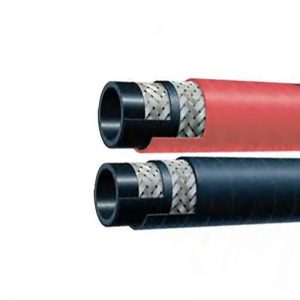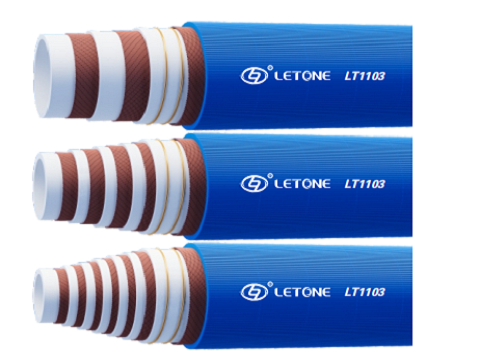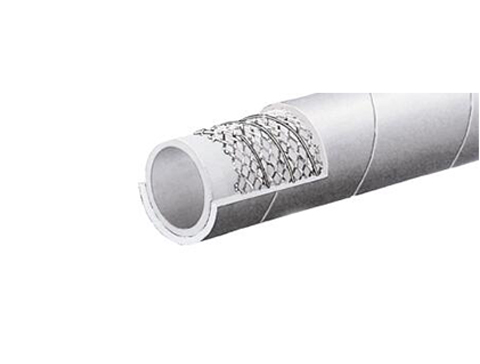EPDM rubber braided steam pipe, as a high-performance industrial pipeline, has demonstrated its unique application value and advantages in multiple fields. This article will provide a detailed explanation of the performance characteristics, production process, application scope, selection and installation precautions, and maintenance management of EPDM rubber braided steam pipes, in order to provide comprehensive and in-depth understanding for practitioners in related fields.
1、 Performance characteristics of EPDM rubber braided steam pipe
EPDM (ethylene propylene diene monomer) braided steam pipes are known for their excellent properties such as high temperature resistance, corrosion resistance, and aging resistance. Firstly, EPDM rubber has high temperature resistance and can maintain its elasticity and sealing properties at temperatures up to 450 degrees Fahrenheit (approximately 232 degrees Celsius), making it highly suitable for transporting high-temperature steam. Secondly, EPDM rubber has good resistance to corrosion by chemicals such as acid, alkali, and salt, which enables it to maintain stable performance even in corrosive environments. In addition, EPDM rubber has a long service life and can maintain its stable performance even in harsh environments such as high temperature, high pressure, and ultraviolet radiation, making it less prone to aging. Finally, EPDM rubber braided steam pipes have the characteristics of being lightweight and easy to install, which can greatly reduce the difficulty and cost of construction.
2、 Production process of EPDM rubber braided steam pipe
The production process of EPDM rubber braided steam pipes is complex and refined, mainly including steps such as raw material mixing, extrusion molding, weaving reinforcement, and vulcanization treatment. Firstly, the raw materials such as ethylene, propylene, and non conjugated dienes are mixed evenly in a plastic container, and then extruded into shape using a hot core extruder. The temperature of the extruder is controlled between 150 and 180 degrees Fahrenheit to ensure that the raw materials can be fully melted and extruded evenly. Next, apply a layer of steel wire reinforcement material on the outer layer of the extruded rubber tube to improve the pressure resistance and wear resistance of the pipeline. Then, a cover made of heat-resistant, oil resistant, and ozone resistant materials such as knitted polyester, synthetic silk, or Kevlar is wrapped around the outer layer to protect the pipeline from external environmental erosion. Finally, the inner and outer materials of the pipeline are tightly bonded through vulcanization treatment, forming EPDM rubber braided steam pipes with excellent performance.
 3、 Application scope of EPDM rubber braided steam pipe
EPDM rubber braided steam pipes have been widely used in various fields due to their excellent performance characteristics. In the industrial field, it is widely used in steam transmission systems in industries such as petroleum, chemical, power, and pharmaceuticals, which can meet the requirements of various high-temperature and corrosive environments. In the food industry, due to its non-toxic, odorless, and easy to clean characteristics, EPDM rubber braided steam pipes are also used in steam conveying applications such as cooking equipment and disinfection equipment. In addition, EPDM rubber braided steam pipes can be used for steam heating pipelines in air conditioning systems, with good insulation and pressure resistance properties. In environmental engineering, it is also used in industrial wastewater treatment, sewage treatment, and discharge systems, which can withstand certain corrosive media and high temperature environments.
4、 Selection and installation precautions of EPDM rubber braided steam pipe
When selecting EPDM rubber braided steam pipes, it is necessary to choose appropriate parameters such as pipe diameter, wall thickness, and material according to the actual usage scenario. At the same time, it is also necessary to consider whether the pressure resistance level, temperature range, and other parameters of the pipeline meet the requirements for use. During the installation process, the following points should be noted: Firstly, specialized connectors should be used at the pipeline connections to ensure a secure and well sealed connection; Secondly, mechanical damage or scratches on the pipeline should be avoided during installation; Again, the issue of thermal expansion of pipelines should be taken into account to avoid damage or leakage caused by stress generated by thermal expansion; Finally, after installation, pressure and leakage tests should be conducted on the pipeline to ensure its safety and stability.
3、 Application scope of EPDM rubber braided steam pipe
EPDM rubber braided steam pipes have been widely used in various fields due to their excellent performance characteristics. In the industrial field, it is widely used in steam transmission systems in industries such as petroleum, chemical, power, and pharmaceuticals, which can meet the requirements of various high-temperature and corrosive environments. In the food industry, due to its non-toxic, odorless, and easy to clean characteristics, EPDM rubber braided steam pipes are also used in steam conveying applications such as cooking equipment and disinfection equipment. In addition, EPDM rubber braided steam pipes can be used for steam heating pipelines in air conditioning systems, with good insulation and pressure resistance properties. In environmental engineering, it is also used in industrial wastewater treatment, sewage treatment, and discharge systems, which can withstand certain corrosive media and high temperature environments.
4、 Selection and installation precautions of EPDM rubber braided steam pipe
When selecting EPDM rubber braided steam pipes, it is necessary to choose appropriate parameters such as pipe diameter, wall thickness, and material according to the actual usage scenario. At the same time, it is also necessary to consider whether the pressure resistance level, temperature range, and other parameters of the pipeline meet the requirements for use. During the installation process, the following points should be noted: Firstly, specialized connectors should be used at the pipeline connections to ensure a secure and well sealed connection; Secondly, mechanical damage or scratches on the pipeline should be avoided during installation; Again, the issue of thermal expansion of pipelines should be taken into account to avoid damage or leakage caused by stress generated by thermal expansion; Finally, after installation, pressure and leakage tests should be conducted on the pipeline to ensure its safety and stability.







